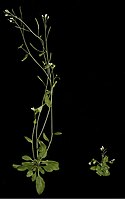
Herbivore resistance in congeneric and sympatric Nothofagus species is not related to leaf habit.
Sign Up to like & getrecommendations! Published in 2019 at "American journal of botany"
DOI: 10.1002/ajb2.1293
Abstract: PREMISE Two fundamental hypotheses on herbivore resistance and leaf habit are the resource availability hypothesis (RAH) and the carbon-nutrient balance hypothesis (CNBH). The RAH predicts higher constitutive resistance by evergreens, and the CNBH predicts higher… read more here.
Keywords: herbivore resistance; leaf habit; defoliation; nothofagus species ... See more keywords

Defoliation management effects on nutritive value of ‘performer’ switchgrass
Sign Up to like & getrecommendations! Published in 2020 at "Crop Science"
DOI: 10.1002/csc2.20036
Abstract: Assigned to Associate Editor Guillermo Scaglia. Abstract Forage species with greater nutritive value have the potential to positively affect animal responses. ‘Performer’ switchgrass (Panicum virgatum L.) was released because of greater digestibility and lower lignin… read more here.
Keywords: nutritive value; defoliation; performer switchgrass; defoliation management ... See more keywords

How to quantify plant tolerance to loss of biomass?
Sign Up to like & getrecommendations! Published in 2017 at "Ecology and Evolution"
DOI: 10.1002/ece3.2907
Abstract: Abstract In some plant species the whole shoot is occasionally removed, as a result of specialist herbivory, grazing, mowing, or other causes. The plant can adapt to defoliation by allocating more to tolerance and less… read more here.
Keywords: plant; tolerance; biomass; defoliation ... See more keywords

Insect defoliation modulates influence of climate on the growth of tree species in the boreal mixed forests of eastern Canada
Sign Up to like & getrecommendations! Published in 2022 at "Ecology and Evolution"
DOI: 10.1002/ece3.8656
Abstract: Abstract Increasing air temperatures and changing precipitation patterns due to climate change can affect tree growth in boreal forests. Periodic insect outbreaks affect the growth trajectory of trees, making it difficult to quantify the climate… read more here.
Keywords: defoliation; insect defoliation; growth; spruce budworm ... See more keywords

Impacts of spruce budworm defoliation on the habitat of woodland caribou, moose, and their main predators
Sign Up to like & getrecommendations! Published in 2022 at "Ecology and Evolution"
DOI: 10.1002/ece3.8695
Abstract: Abstract Forest logging has contributed to the decline of several woodland caribou populations by causing the fragmentation of mature coniferous stands. Such habitat alterations could be worsened by spruce budworm (SBW) outbreaks. Using 6201 vegetation… read more here.
Keywords: defoliation; main predators; caribou; spruce budworm ... See more keywords

Defoliation and arbuscular mycorrhizal fungi shape plant communities in overgrazed semiarid grasslands.
Sign Up to like & getrecommendations! Published in 2018 at "Ecology"
DOI: 10.1002/ecy.2401
Abstract: Overgrazing substantially contributes to global grassland degradation by decreasing plant community productivity and diversity through trampling, defoliation, and removal of nutrients. Arbuscular mycorrhizal (AM) fungi also play a critical role in plant community diversity, composition,… read more here.
Keywords: plant; mycorrhizal fungi; defoliation; arbuscular mycorrhizal ... See more keywords

Fosetyl-aluminium injection controls root rot disease affecting Quercus suber in southern Spain
Sign Up to like & getrecommendations! Published in 2019 at "European Journal of Plant Pathology"
DOI: 10.1007/s10658-019-01865-1
Abstract: In Spain, natural and managed cork oak woodlands are severely affected by decline caused by the root rot oomycetes Phytophthora cinnamomi and Pythium spiculum. The need for environmental-friendly disease management makes the use of resistance… read more here.
Keywords: fosetyl aluminium; root rot; defoliation; cork ... See more keywords

Interaction effects of water supply and artificial defoliation in autumn on growth, biomass and nutrient accumulation in Populus deltoides
Sign Up to like & getrecommendations! Published in 2021 at "New Forests"
DOI: 10.1007/s11056-021-09837-2
Abstract: Poplar productivity is negatively affected by excess or deficit of water availability and by insect and pathogens that cause defoliation. Some foliar diseases, like leaf rust, produce defoliation at the end of the summer. The… read more here.
Keywords: growth; water; accumulation; biomass ... See more keywords

Effects of forest tent caterpillar defoliation on carbon and water fluxes in a boreal aspen stand
Sign Up to like & getrecommendations! Published in 2018 at "Agricultural and Forest Meteorology"
DOI: 10.1016/j.agrformet.2018.01.035
Abstract: Abstract Insect outbreaks can significantly influence carbon (C) and water balances of forests. Forest tent caterpillars (FTC) ( Malacosoma disstria Hubner) are one of the most prominent insects found in aspen forests in Canada and… read more here.
Keywords: carbon water; water fluxes; defoliation; forest tent ... See more keywords

Quantification of forest canopy changes caused by spruce budworm defoliation using digital hemispherical imagery
Sign Up to like & getrecommendations! Published in 2018 at "Agricultural and Forest Meteorology"
DOI: 10.1016/j.agrformet.2018.07.006
Abstract: Abstract Detection of spruce budworm (Choristoneura fumiferana Clem.) defoliation is critical for forest protection strategies aimed at minimizing losses in growth and mortality. However current aerial and ground survey methods of detecting defoliation are imprecise… read more here.
Keywords: canopy; spruce budworm; defoliation; budworm defoliation ... See more keywords

Tree canopy defoliation can reveal growth decline in mid-latitude temperate forests
Sign Up to like & getrecommendations! Published in 2021 at "Ecological Indicators"
DOI: 10.1016/j.ecolind.2021.107749
Abstract: Abstract Climate and weather fluctuations and changes are the most important environmental drivers of tree canopy defoliation, an indicator of forest health. We examined the relationship between tree defoliation and Basal Area Increment (BAI), a… read more here.
Keywords: growth; canopy defoliation; tree canopy; defoliation reveal ... See more keywords